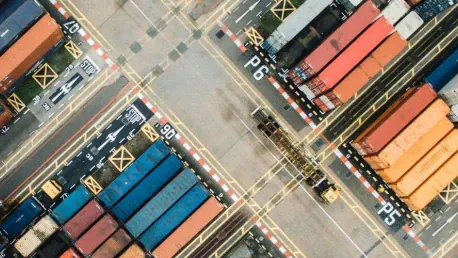The maritime industry recently saw significant container spill incidents involving the CMA CGM Belem and MSC Antonia off the coast of South Africa. Together, these incidents resulted in the loss of 145 containers. Yet, experts suggest these isolated events are unlikely to significantly impact cargo insurance rates. This article delves into the nuanced factors influencing maritime cargo insurance and offers insights into broader trends affecting the industry.
Analyzing Recent Container Spills
Incident Overview
In August 2024, two major container spills off the South African coast stirred discussions within the maritime industry. The CMA CGM Belem lost 99 containers, while the MSC Antonia saw 46 containers overboard. These incidents underscore the ever-present risks in maritime transport but are part of a longer history of such occurrences.
Despite the alarming numbers involved, industry experts, including Mike Brews of Horizon Underwriting Managers, argue that these incidents will not drastically alter cargo insurance rates. The reasoning rests on the broader context of global maritime cargo movement, which sees around 250 million containers transported annually. Compared to this vast volume, the loss of 145 containers, although significant locally, remains relatively minor in the grander scheme. The established practices and mechanisms within the industry ensure efficient management and mitigation of such losses, curbing any significant impact on insurance rates.
Immediate Impact and Response
Despite the loss of 145 containers, experts like Mike Brews of Horizon Underwriting Managers argue that these incidents will not drastically alter cargo insurance rates. According to Brews, the volume of global maritime cargo movement significantly overshadows individual container losses. The industry has developed robust mechanisms to manage and mitigate such occurrences efficiently.
Additionally, the industry’s swift response to these incidents showcases the preparedness of maritime insurance bodies and shipping companies in handling such crises. The well-coordinated efforts to recover lost containers and mitigate environmental impacts demonstrate a mature and responsive approach. This quick action reassures stakeholders and promotes a stable risk environment, ultimately safeguarding insurance rates from drastic fluctuations. Brews’ insights highlight the balance between recognizing the local significance of such events and understanding their limited influence globally.
Historical Context
Over the years, container spills have occasionally grabbed headlines, but their sporadic nature limits their influence on broader insurance trends. The maritime sector handles around 250 million containers annually, and while each incident is significant locally, it remains relatively minor in the grander scheme of global cargo movement.
These historical incidents provide context and reassurance that isolated container spills are manageable within established risk frameworks. The maritime industry, having adapted to various challenges over time, continues to exhibit resilience. This resilience is reflected in the stability of cargo insurance rates, which remain less volatile despite occasional high-profile container losses. Understanding the frequency and outcomes of past spills helps paint a complete picture of the industry’s robustness in the face of such incidents.
Broader Risk Factors in Maritime Cargo Insurance
Weather-Related Events
The upcoming International Union of Marine Insurance (IUMI) conference in Berlin will address severe weather’s impact on ocean cargo. Incidents such as those involving the CMA CGM Belem and MSC Antonia are part of broader patterns of risk associated with extreme weather events. These events have a more substantial influence on insurance practices and rates than isolated container spills.
Severe weather events are an enduring concern within maritime logistics, influencing a wide array of risk management strategies. The IUMI conference aims to underscore the importance of anticipating and mitigating these risks through advanced forecasting and preparedness techniques. By drawing attention to the global impact of extreme weather on maritime operations, the conference seeks to foster collaborative solutions. The enduring challenges of navigating storm-prone areas highlight the necessity of improving resilience through continuous innovation and adaptive insurance models.
Localized Factors in South Africa
In South Africa, cargo insurance rates are more significantly impacted by other factors like cargo theft, civil unrest, and infrastructural damage from natural disasters such as flooding. These elements present more consistent and pervasive risks than container spills, shaping the local insurance landscape in deeper ways.
Recent historical events serve as a poignant reminder of the volatility affecting the South African maritime sector. The Durban riots in 2021, for example, had significant repercussions on local cargo insurance rates, more so than sporadic container spills. Such events highlight the need for comprehensive risk assessments that account for social and infrastructural vulnerabilities. The interplay of theft, civil unrest, and natural calamities delineate the risk environment, reiterating that container spills are just one of many factors influencing insurance trends in the region.
Statistical Trends and Long-Term Measures
Insurance companies often take a long-term perspective, evaluating risk over 5-year and 50-year cycles. This approach helps smooth out the impact of isolated incidents, with significant events like the Durban riots in 2021 having a more pronounced effect over time. By focusing on longer trends, insurers can manage and predict future risks more accurately.
Such long-term measures allow for a holistic understanding of risk, encapsulating a range of factors from political instability to climate change. This comprehensive viewpoint ensures that the evaluation process remains balanced, mitigating the potential for overreaction to sporadic incidents like container spills. The methodologies employed for statistical trend analysis help reinforce resilience within the insurance sector, equipping it to address both immediate and evolving threats effectively.
Industry Practices and Safety Measures
Evolving Safety Protocols
One significant change in the industry has been the reduction of premature unlashing practices, which previously contributed to higher incidences of cargo loss. The maritime sector’s proactive stance in adopting improved lashing techniques has played a crucial role in mitigating the risks associated with container spills.
This evolution in safety protocols underscores the industry’s commitment to continuous improvement. By refining lashing techniques and enforcing stricter adherence to safety standards, the sector has demonstrated a proactive approach to risk management. These improved practices not only enhance the physical security of cargo but also foster confidence among stakeholders, contributing to the stability of insurance rates. The successful reduction in cargo loss incidents affirms the efficacy of these enhanced safety measures.
Training and Preparedness
Another focal point has been enhancing training and preparedness for navigating storm-prone areas. By prioritizing these areas, the maritime industry aims to minimize the impact of severe weather, further stabilizing insurance rates. Advanced training ensures that crews are better equipped to handle adverse conditions, reducing the likelihood of container loss.
Enhanced training programs are pivotal in fostering a culture of preparedness and resilience within the maritime industry. By emphasizing the importance of weather forecasting and route planning, these programs aim to reduce the risks posed by adverse weather conditions. The industry’s investment in crew education and advanced simulation exercises illustrates its proactive stance in risk mitigation. These comprehensive training initiatives are critical in maintaining operational stability and, by extension, ensuring consistent insurance rates, even in the face of unpredictable weather patterns.
Technological Advancements
Technological advancements have also played a role in improving safety measures. Innovations such as better tracking systems and more reliable weather forecasting tools allow for more effective risk management. These tools enable carriers to avoid dangerous weather patterns and reduce the likelihood of accidents.
The integration of cutting-edge technology in maritime operations reflects a forward-thinking approach to risk management. Enhanced tracking systems provide real-time monitoring of cargo, offering unprecedented levels of visibility and control. Meanwhile, advancements in weather forecasting enable more precise predictions, aiding in the avoidance of storm-prone areas. Together, these technological innovations reinforce the industry’s capacity to manage risks and maintain stability in cargo insurance rates. By leveraging these tools, the maritime sector continues to set new standards in safety and efficiency.
Stable Insurance Rates Amidst Fluctuating Events
Resilience of the Insurance Market
Despite recent container spills and other extreme weather events, cargo insurance rates have remained relatively stable. This resilience stems from the industry’s ability to adapt and implement better safety measures. The consistent application of these practices demonstrates a robust risk management framework that can absorb isolated incidents without major disruptions.
The maritime insurance market’s resilience is a testament to its adaptive strategies and proactive risk management. The industry’s emphasis on continuous improvement and its systemic approach to addressing risks play a pivotal role in maintaining stability. By embedding resilience into every facet of operations, from safety protocols to technological innovations, the sector ensures that insurance rates remain stable despite fluctuating events. This ability to absorb and adapt to challenges underscores the robustness of the maritime insurance framework.
Influence of Major Events
Significant changes in insurance rates tend to be driven by major, impactful events rather than isolated container spills. For example, large-scale incidents involving theft or natural disasters have a more substantial influence on rate adjustments. This trend indicates a preference for a long-term, holistic view of risk rather than reacting to short-term fluctuations.
The maritime insurance industry’s preference for a long-term perspective helps in maintaining equilibrium amidst short-term disruptions. This approach emphasizes the importance of broader, systemic risk factors over isolated incidents. By focusing on major events, such as natural disasters or large-scale thefts, insurers can better anticipate trends and mitigate potential risks. This balanced viewpoint helps in avoiding overreaction to individual incidents, thereby preserving the stability of insurance rates, and fostering confidence in the global maritime logistics system.
Long-Term Stability
The maritime industry recently experienced notable container spill incidents involving the CMA CGM Belem and MSC Antonia off the coast of South Africa, resulting in the loss of 145 containers. Despite the magnitude of these events, experts believe these isolated incidents are not likely to significantly impact cargo insurance rates in the long term. According to industry analysts, the resilience of maritime insurance has been tested numerous times, and it is designed to absorb such occurrences without drastic changes in premium costs.
This article explores the complex array of factors that influence maritime cargo insurance, including the frequency and severity of incidents, advancements in technology, and improvements in risk management practices. Additionally, it looks into broader trends shaping the industry, such as shifts in global trade routes, the increasing size of container ships, and evolving regulatory frameworks. The interplay between these factors ensures that while notable spill incidents do raise concerns, they are insufficient to cause substantial changes in insurance rates by themselves.









